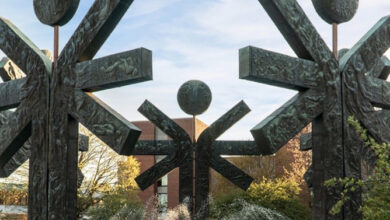Soldiers on the march: Ron Zorn recreates historic battle scenes
by Terra Osterling
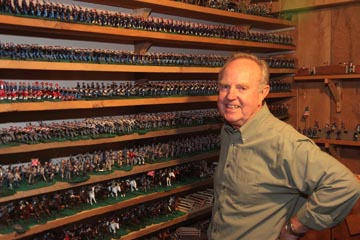 Ron stands along just one of many racks of figures he has cast and painted. In all, he has made over 8,000 of them.Living in Los Angeles as a young boy during World War II, Ron Zorn of Churchville remembers seeing Marines passing through, headed overseas, and even then understood their sacrifice.
Ron stands along just one of many racks of figures he has cast and painted. In all, he has made over 8,000 of them.Living in Los Angeles as a young boy during World War II, Ron Zorn of Churchville remembers seeing Marines passing through, headed overseas, and even then understood their sacrifice.
A generation later, after a 35 year career teaching physics at Spencerport High School, that same reverence for sacrifice and love of country is what has driven Zorn to cast and paint thousands of lead soldiers. His painstaking research has resulted in recreated battle scenes from the Revolutionary War, Civil War and, most recently on display at the Newman-Riga Library, the War of 1812.
“It wasn’t easy,” says Zorn of the military campaigns that have kept our country first independent, then united — “(These) trials and tribulations to get us where we are … inspired me to do something.”
“So much of our history is based on forts and wars,” says Zorn, explaining that in addition to in-depth reading, he and wife, Alice, have visited forts, cemeteries and historic battle sites to learn about the nation’s early conflicts.
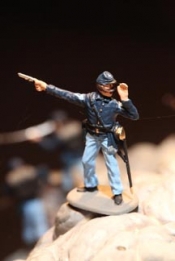 A close up of the figure of Colonel Patrick O’Rorke shows the high degree of detail Ron incorporates in his cast figures. Colonel Patrick O’Rorke, a local hero, led his men to repulse the Rebels. The 140th regiment, a grouping that included many men from Churchville and Chili and some men from Ogden and Brockport; the Rebels were made up of men from Texas and Alabama.In particular, Zorn researches the local 140th Regiment of the New York Infantry and the Civil War battles in which they fought. He also has a special interest in the Revolutionary War.
A close up of the figure of Colonel Patrick O’Rorke shows the high degree of detail Ron incorporates in his cast figures. Colonel Patrick O’Rorke, a local hero, led his men to repulse the Rebels. The 140th regiment, a grouping that included many men from Churchville and Chili and some men from Ogden and Brockport; the Rebels were made up of men from Texas and Alabama.In particular, Zorn researches the local 140th Regiment of the New York Infantry and the Civil War battles in which they fought. He also has a special interest in the Revolutionary War.
 Some of the cannons Ron built from cast parts. He builds all his figures and pieces on a 1/32 scale.His recent display at the Newman Riga Library was of the War of 1812 Battle of Chippewa at what is now Niagara-on-the-Lake, Ontario, Canada.
Some of the cannons Ron built from cast parts. He builds all his figures and pieces on a 1/32 scale.His recent display at the Newman Riga Library was of the War of 1812 Battle of Chippewa at what is now Niagara-on-the-Lake, Ontario, Canada.
“It was the first time the United States had an organized army with uniformed ‘regulars,’ ” says Zorn, much to the surprise of the British, who were pushed back to Fort George. He emphasizes the significance of the Battle of Chippewa because it was the Americans’ first showing as professional soldiers instead of poorly trained militia.
“That’s why I happened to pick that particular battle for the display,” Zorn says of the defining moment in American military history.
Zorn had already once visited Fort Niagara, the American fort now a historic site in Youngstown, N.Y., but needed to make 1812-era soldiers. He got to work on the figures, acquired a map of the battle and began researching in books and on the internet to reconstruct the scene as accurately as possible, including the uniform colors and styling.
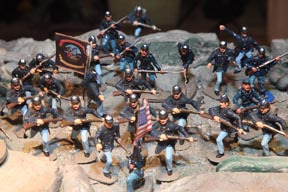 A diorama of the battle of Little Round Top, a key Union victory during the Battle of Gettysburg, features simulated rock formations and soldiers from the Union and the Confederate States. Leading the 140th Regiment Union defense is the figure of Colonel Patrick O’Rorke, standing on a high point.During this research process, Zorn discovered that the Americans had switched to gray uniforms around this time due to a shortage of blue fabric. He further learned that the gray West Point Military Academy dress uniform is a replica of the uniform worn by the Americans at the Battle of Chippewa.
A diorama of the battle of Little Round Top, a key Union victory during the Battle of Gettysburg, features simulated rock formations and soldiers from the Union and the Confederate States. Leading the 140th Regiment Union defense is the figure of Colonel Patrick O’Rorke, standing on a high point.During this research process, Zorn discovered that the Americans had switched to gray uniforms around this time due to a shortage of blue fabric. He further learned that the gray West Point Military Academy dress uniform is a replica of the uniform worn by the Americans at the Battle of Chippewa.
He set to work painting gray-uniformed soldiers as well as Native American figures to represent the Mohawk and Seneca, who, he says, had chosen sides for a proxy battle.
A history of loving history
Zorn has been consumed by history since boyhood, admiring the local doctor’s flintlock rifle collection, watching Daniel Boone movies and the Revolutionary War film “Drums Along the Mohawk.” Artistic talent passed down from his mother, who he remembers painting ceramics and beads, was encouraged by his third grade teacher. While he went on to follow math and science through college and career, he returned to art in retirement after receiving figure molds as a birthday gift.
 To get different configurations of soldiers Ron casts individual parts like left and right arms, rifles, cannons and other elements. He molds figure’s arms (left and right), rifles, cannons to put as much realism as he can into the castings. Parts are put together using Superglue and Tacky Glue. He paints the pieces appropriately, using information he gleans from his library of books about American battles. “It’s more fun to make the molds yourself,” says Zorn, going on to describe the roughly ninety-minute, thirteen-step process from the clay impression, to mold, to completed 1:32 scale lead (or tin) soldier.
To get different configurations of soldiers Ron casts individual parts like left and right arms, rifles, cannons and other elements. He molds figure’s arms (left and right), rifles, cannons to put as much realism as he can into the castings. Parts are put together using Superglue and Tacky Glue. He paints the pieces appropriately, using information he gleans from his library of books about American battles. “It’s more fun to make the molds yourself,” says Zorn, going on to describe the roughly ninety-minute, thirteen-step process from the clay impression, to mold, to completed 1:32 scale lead (or tin) soldier.
“You’re never pressed for time when you’re retired and you don’t want to rush,” he says. One out of every ten soldiers may be returned to Zorn’s melting pot if they don’t meet muster and he is careful to keep his work area ventilated and to protect himself from spills. While watching history programs in the mornings, he paints in both acrylics (for a matte finish and faster drying time) and oil enamels (his preferred medium for a shiny finish).
 Zorn concentrates on the details as he paints a miniature soldier for a diorama of a battle. A lover of history, the retired Spencerport high school physics teacher has cast thousands of figures in a 13 step process to complete 1:32 scale lead or tin soldiers. His painting table is surrounded by books, photos, and postcards for reference. Off to one side is a tray of lead arms to be attached later; Ron says that extended limbs easily break off in the casting process so he casts these separately. A wooden block holds increasingly finer paintbrushes, though “you can’t get a brush fine enough for the whites of eyes,” says Zorn of this detailed work.
Zorn concentrates on the details as he paints a miniature soldier for a diorama of a battle. A lover of history, the retired Spencerport high school physics teacher has cast thousands of figures in a 13 step process to complete 1:32 scale lead or tin soldiers. His painting table is surrounded by books, photos, and postcards for reference. Off to one side is a tray of lead arms to be attached later; Ron says that extended limbs easily break off in the casting process so he casts these separately. A wooden block holds increasingly finer paintbrushes, though “you can’t get a brush fine enough for the whites of eyes,” says Zorn of this detailed work.
“No matter the project – if you have the proper tools, you can do anything,” says this grandson of a tool-and-die maker who worked for George Eastman.
“Having the ability to put things together with your hands,” is another of Zorn’s inherited talents and a deeply held value. In fact, lead soldier displays are only one among a long list of projects Zorn has undertaken in retirement.
Together with his entire family, Zorn has built his and Alice’s cabin-styled home in Churchville, homes for his children, and is currently working on centerpieces for his granddaughter’s wedding in the Adirondacks later this summer. In fact, when Alice pondered ideas for the bride and groom’s table, she says that Ron came out of the workshop 24 hours later with beautifully painted wooden loons.
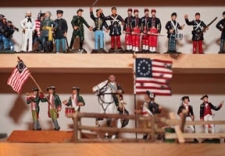 A rack of United States Civil War soldiers is layered over a rack of Revolutionary War figures.
A rack of United States Civil War soldiers is layered over a rack of Revolutionary War figures.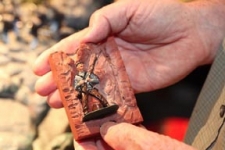 Making soldiers involves creating a mold out of an original figure from epoxy and hardener. The mold is split in half and rejoined, then molten pewter, at about 600 degrees F is poured into the mold. After about ten minutes, the mold is pulled apart and later Ron paints the details, even the lips on the faces, using very fine brushes and enamel paint.Zorn’s basement workshop is also the “barracks” – one area of 23 floor-to-ceiling reinforced shelves holds 300 soldiers on each, amounting to nearly 7,000 marching, rifle-aiming and charging figures. In addition to those shelves, nearly every horizontal surface, including overhead basement wall framing, is lined with soldiers at the ready.
Making soldiers involves creating a mold out of an original figure from epoxy and hardener. The mold is split in half and rejoined, then molten pewter, at about 600 degrees F is poured into the mold. After about ten minutes, the mold is pulled apart and later Ron paints the details, even the lips on the faces, using very fine brushes and enamel paint.Zorn’s basement workshop is also the “barracks” – one area of 23 floor-to-ceiling reinforced shelves holds 300 soldiers on each, amounting to nearly 7,000 marching, rifle-aiming and charging figures. In addition to those shelves, nearly every horizontal surface, including overhead basement wall framing, is lined with soldiers at the ready.
“He looks at each as a child, a creation,” says Alice, explaining why Ron doesn’t sell his soldiers and battle scenes, or the fine antebellum ladies, Santa Clauses, Mrs. Clauses, snowmen, nutcrackers and sports figures that become gifts for family and friends.
While wondering whether all this labor will ever do anyone else any good, Zorn answers his own question when he says, “The value is in the doing and in someone gaining some appreciation of our history — that’s the ultimate reward.”
Zorn continues to research the 140th Regiment and is always pleased for the opportunity to display his work for the community. The Battle of Chippewa was one of a half-dozen displays that have been exhibited at the Newman-Riga Library and the Zorns’ recent visit to Fort Stevens, near Washington, D.C., was in preparation for a depiction of the first Civil War battle at Manassas, Virginia, for Ron’s next display at the Library.



